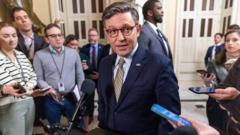The use of American ATACMS missiles by Ukraine signifies a new phase in the conflict with Russia. As tensions rise, President Putin attempts to leverage nuclear threats to deter U.S. support for Ukraine. Meanwhile, U.S. officials downplay the situation, reflecting a growing desensitization to nuclear threats in international politics.
Ukraine Utilizes U.S.-Made Missiles to Strike Inside Russian Territory

Ukraine Utilizes U.S.-Made Missiles to Strike Inside Russian Territory
In a significant escalation of the ongoing conflict, Ukraine has launched U.S.-made missiles into Russia for the first time, targeting an ammunition depot amidst heightened nuclear threats from Putin.
In a notable development in the Ukraine-Russia war, Ukraine's military made a historic move by deploying U.S.-made Army Tactical Missile Systems (ATACMS) to strike Russian territory. This attack, which occurred on November 18, 2024, targeted an ammunition depot in the Bryansk region of southwestern Russia. It marks a significant escalation, as this is the first instance of Ukraine utilizing American-made ballistic weapons against Russia.
The operation coincided with a critical moment in the conflict, as Russian President Vladimir Putin announced an adjustment to Russia's nuclear policy, lowering the threshold for nuclear weapon usage. This strategic timing suggests that the Kremlin aims to send a stern warning amid Ukraine's increasing military capabilities supported by the U.S.
President Biden recently authorized the use of long-range missiles by Ukraine for operations inside Russia, signaling a shift in U.S. military support. In response to these developments, the White House has attempted to downplay the implications of Putin’s revised nuclear doctrine, noting that there have been “no changes to Russia’s nuclear posture” observed by U.S. officials.
The sophistication of the military operation reflects Ukraine's adaptation and resilience in the ongoing conflict. However, Washington's measured response to the missile strikes is indicative of a longer trend; the war in Ukraine has increasingly desensitized both U.S. and global observers to the specter of nuclear conflict, as highlighted by David Sanger from The New York Times.
Concerns are also mounting in Europe, particularly following comments from Germany's defense minister regarding potential Russian hybrid warfare tactics aimed at retaliating against Western support for Ukraine. The severing of two fiber-optic cables in the Baltic Sea has raised alarms about possible sabotage acts attributed to the Kremlin.
As the situation continues to evolve, both the geopolitical landscape and the nature of military engagement in Ukraine will likely face further complexities, with the specter of nuclear warfare remaining a pivotal concern on the horizon.




















